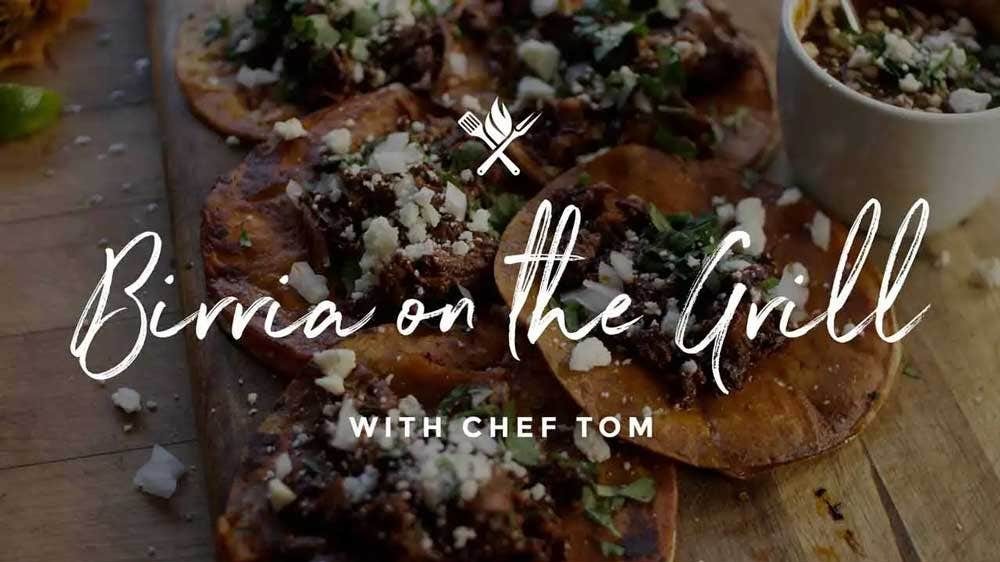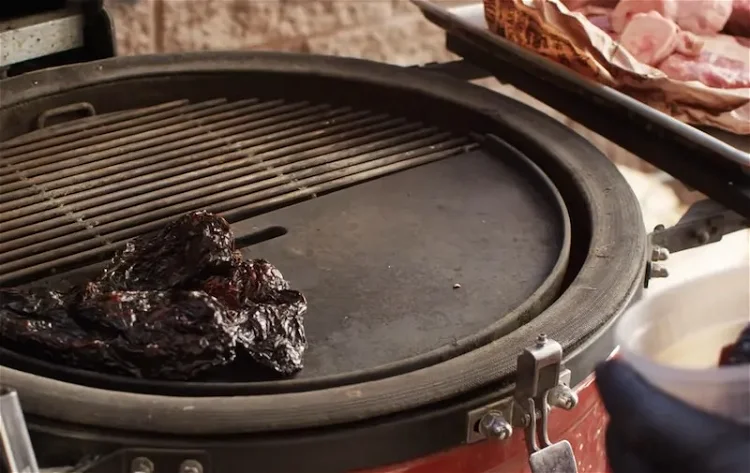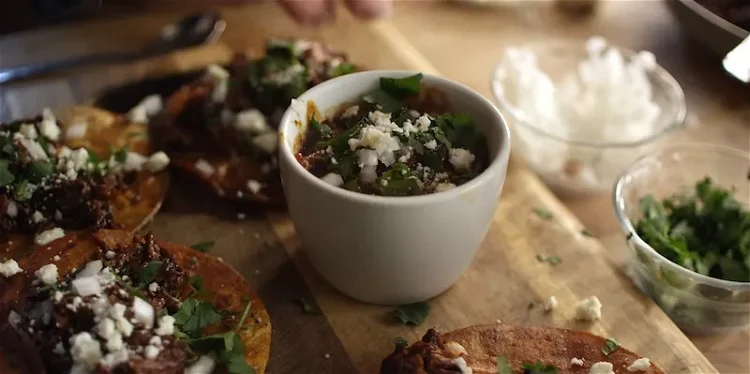Create authentic Mexican flavors with this classic street vendor recipe, made better on the grill. Enjoy this delicious recipe and the unbeatable taste of Mexico!

Birria on the Grill
Tom Jackson
Rated 5.0 stars by 1 users
Category
Lunch
Cuisine
Mexican
Servings
8+
Prep Time
10 minutes
Cook Time
3 hours
Calories
619
Make this street vendor classic at home on the grill and enjoy some of the classic flavors of old school Mexico.
Ingredients
- 4 lb bone-in beef shank (short ribs)
- 12 oz beef marrow bones
-
Jacobsen Salt Co. Kosher Sea Salt
-
Jacobsen Salt Co. Tellicherry Black Peppercorns
- 1 tbsp avocado oil
- 4 guajillo chiles
- 4 pasilla chiles
- 4 ancho chiles
- 2 chipotle chiles
- 2 cups white onion, diced
- 10 garlic cloves, crushed, peeled
- 1 tbsp minced fresh ginger
-
1 (29 oz) can Ciao Italian canned tomatoes
-
1/4 cup Cattleman’s Grill Mexicano Seasoning
- 1/4 cup smoked paprika
- 2 tbsp dried Mexican oregano
- 2 quarts beef stock
- 2 quarts water
- 3-4 bay leaves
- 1” cinnamon stick
- 1 tsp cloves
- 1 tsp juniper or allspice berries
- Corn tortillas
- Diced onion
- Fresh cilantro
- Lime wedges
- Queso fresco
In the Sachet:
For the tacos:
Directions
- Build a hot charcoal fire in the Kamado Joe Classic III Ceramic Charcoal Grill. Open up that air flow to 550ºF. Set up half of the grill with a Half Moon Cast Iron Skillet, smooth side up, and the other half with the standard grate.
- Remove the stems and seeds from the dried chiles. Toast them on the griddle until they are aromatic and softened, which should take about 30-60 seconds per side. Take them off and set aside for now.
- Season your beef with Jacobsen Salt Co. Kosher Salt and fresh cracked Jacobsen Tellicherry Black Peppercorn. Pour some avocado oil on all sides. Be sure to work in batches so as to not overcrowd the dutch oven. Sear the beef on all sides, remove and set aside.

- Toss the diced onions in the dutch oven. Cook them until they are translucent, then add the garlic and ginger. Let that cook for about a minute, then add the canned tomatoes and seasonings. Stir it all up to incorporate and break up the tomatoes.
- Throw in the toasted dried chiles along with some beef stock and the sachet. Bring the red chile sauce to a simmer. Cover it with the lid, then close the Kamado Joe and stabilize the temperature at 350ºF.
- Cook until the chiles are tender and rehydrated, which should take about 20 minutes. Remove the chiles from the broth and transfer them to the blender. Add the 2 cups of broth to the blender and blend until totally smooth. You can strain that chile sauce if you feel the need, but that's certainly not necessary if you're using a Vitamix blender.

- Drop the beef chunks and marrow bones to the dutch oven. Return the puréed chile mixture to the broth. Rinse out the pitcher with water and throw that in. Cover with a lid.
- Cook until you've got boneless beef that's pull apart tender, which should take at least 2 hours. You can add additional water as needed to keep the beef submerged.
- Remove the sachet from the broth as well as the beef, which should fall right off the bones. Chop up the beef and discard the bones.
- Add water to the broth until it has a soup-like consistency. Return it to the grill on medium heat.
- To make birria tacos, use two warm corn tortillas per taco. Dip one in the beef broth, then toast it on the griddle. Toast the second one on the griddle without dipping. When the tortillas are lightly toasted but still soft, place the tortilla dipped in beef broth on top of the plain tortilla and add the shredded beef. Top it all with chopped onions, chopped cilantro and crumbled cheese. Ladle some broth over the taco and serve.
- To serve as a birria stew, ladle the broth into a bowl or cup, then add the shredded meat. Garnish the same way you did with the tacos.

- If you end up with leftovers, you can freeze them to enjoy this beautiful birria later, too!

Recipe Note
You might also enjoy: Smoked Tri-Tip on the Kamado Joe Classic III
Nutrition
Nutrition
- Serving Size
- 13.12 oz
- per serving
- Calories
- 619
Amount/Serving
% Daily Value
- Carbs
- 46.3 grams
- Protein
- 58.5 grams
- Fat
- 23.7 grams
- Sodium
- 614 milligrams
Leave a comment